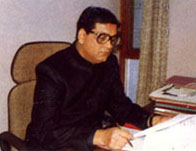Dr. Bindeshwar Pathak
Dr.
Bindeshwar Pathak, Ph.D. is a great humanist and social reformer of
contemporary India. To the weaker sections of society especially, his
is the compassionate face of a paternal redeemer. He has the vision of
a philosopher and the undying zeal of a missionary. He is the icon of a
new culture which embraces the poor and extols the dignity of labor.
His boundless love for the downtrodden finds expression in myriad and
tangible ways. No wonder those who know him intimately swear that Dr.
Pathak is born to help the helpless.
He is the leader of
a national
crusade for restoration of human rights and dignity to millions of
scavengers (cleaners and carriers of human excreta), traditionally
known
as untouchables; and for providing safe and hygienic human waste
disposal systems to the 700 million Indians who go outside
for
open defecation even along roads and railway tracks described
graphically by V.S. Naipaul and Ronal Segal. He has himself identified
with the problems of the untouchables.
 His Holiness Pope John Paul II gave audience to Dr. Bindeshwar Pathak before awarding him with international St. Francis Prize for the Environment “Canticle of All Creatures” in 1992. |
To him goes the credit of sensitizing Indians towards sanitation and those engaged in the sanitation work. Apart from low-cost sanitation, his contributions are widely known in the areas of bio-energy and bio-fertilizer, liquid and solid waste management, and poverty alleviation. In fact, he is a Renaissance Man and combines in himself the traits of a social scientist, an engineer, an administrator, and an institution-builder. What is remarkable is that he has ingeniously utilized all this expertise to enrich and empower the depressed classes.
The widespread phenomenon of defecation in the open remains grim even after 50 years of India’s Independence. Women especially suffer a lot due to non-availability of toilets. Even today 110 million Indian houses have no toilets and 12 million houses have bucket toilets causing filth and diseases. The situation is so appalling that about a half million children die every year due to dehydration caused by open defecation.
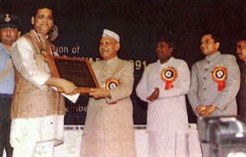 Dr Pathak receiving National Citizen’s Award from the then President, Dr. Shanker Dayal Sharma. |
Gandhi had two ideas in mind while talking about sanitation: one, that no one should clean and carry human excreta of others just to earn one’s livelihood. There must be some scientific method of human waste disposal system. Finding no other affordable alternative during his lifetime, Gandhi had suggested ‘Tatti par mitti’ (cover human excreta with soil) or use of the trench latrine which he himself used while living in Phoenix Ashram in South Africa. Secondly, Gandhi wanted that those who are engaged in sanitation work should not be treated as untouchables. They should get equal respect in the society, he took pains to emphasize, and in his typical style went on to declare that “the Bhangi (scavenger) is as important as the Viceroy”.
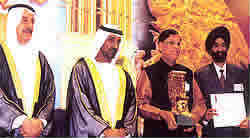 The Dubai International Award for best practices to improve the living Environment. |
The New York Times, in the article Untouchables gain the help of a Brahmin, hailed him as a “full-time crusader against the humiliations of untouchability”. His contribution in abolishing the inhuman practice of scavenging is seminal and unparalleled in the sense that he not only studied the social evil but provided its categorical solution through a low-cost toilet-technology and developed a self-sustaining sanitation system across the country.
In the process of providing alternative to scavenging and rehabilitation and social upgradation of scavengers, Dr. Pathak created a pan-Indian network with 50,000 volunteers and gave birth to what is popularly known as the Sulabh Sanitation Movement. “Nobody should go outside for defecation and every house in India should have a toilet” has become the passionate obsession of Dr. Pathak.
 In 1991, Dr. Pathak was conferred Padma Bhushan by the President of India Mr R.Venkataraman for his “distinguished social service”. |
Expensive systems like sewerage and septic tanks are not cost-effective and affordable for the teeming millions in the Third World. When he came up with the Sulabh technology in 1970, it was first greeted with scepticism and derision; but in 1996 it was declared a global “Urban Best Practice” at the Habitat-II conference held at Istanbul and the Economic and Social Council of United Nations has granted Special Consultative Status to Sulabh in recognition of its outstanding service. Sulabh was also the recepient of the Dubai International Award for “Best Practice to Improve the Living Environment” in 2004.
“You are helping the poor”, lauded Pope John Paul II when Dr. Pathak received the International St. Francis Prize for the Environment in 1992. The President of India earlier conferred on him Padma Bhushan, a very distinctive national award like Knighthood in United Kingdom, for his distinguished services rendered to the nation. Honors and acclaims, both national and international, have come a dime a dozen for Dr. Pathak but what inspires him is the deep love of his country and its people.
Radical beginning
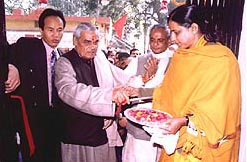 Hon’ble Prime Minister of India Mr. Atal Behari Vajpayee, inaugurating Sulabh built community center in Lucknow. |
Dr. Pathak travelled all over the country, visited and lived with scavengers in their villages, studied their habits and social mores (he did his Ph. D. on scavenging), their history and geographical spread to eventually declare that scavengers were a special class united in their miseries and social degradation. “Let us save them from squalid conditions and in doing so we’ll be saving the national conscience”, Dr. Pathak said.
Significantly, it was not a mere emotional outburst by the young Dr. Pathak, who by that time had fully equipped himself intellectually to construct an irrefutable thesis on the subject. He knew that slogans alone will not help and, hence, developed a technology which has become a credible alternative to scavenging in India.
He observed after studying scriptures that scavenging has no religious sanction and, hence, those who practice untouchability commit a sin; it is unproductive and revolting to manually clean excreta and we are wasting the waste which can be profitably used to raise farm production and produce biogas. He subsequently demonstrated this successfully. The union of theory and practice distinguishes Sulabh from other movements of similar nature.
Dr. Pathak sought to abolish scavenging not only out of sympathy for scavengers but also out of the belief that it is a primitive, expensive, and unhygienic practice which may create an explosive situation in which case a highly dissatisfied group will become dispossessed and then work to destroy the social system. For that matter, the Sulabh Movement is different from other social movements: it is an indigenous concept based on experience and tested scientifically, combining in itself an appropriate technology and demand for social morality.
In simpler words, while other movements identified problems and injustices in society but failed to find solutions, Dr. Pathak identified problems, developed a self-sustaining system, gave an appropriate technology and, finally, solved the problem.
A technological breakthrough
Technology has played a decisive role in the Sulabh Sanitation Movement. During Mahatma Gandhi’s life and even thereafter, several attempts were made to develop a low-cost toilet technology but no tangible result emerged. Dr. Pathak intervened successfully, gave the solution, applied the technology and showed to the engineers, administrators, planners, and masses how it functioned. It was a breakthrough in the Government of India’s program for the eradication of scavenging as the Sulabh system is affordable, acceptable to the masses, and could be set up with the available local facilities. Thus, a low-cost technology was developed by Dr. Pathak to make towns and villages scavenging-free.
The Sulabh technology is a very simple device. It consists of two pits and a sealed cover. While one is in use, the other pit, which has earlier been filled up, is left idle to convert the excreta to manure. By using this technology, there is no need to physically clean human excreta. This was named “Sulabh Shauchalaya”, which could be adopted in different hydrogeological conditions with some precautions.
Dr. Pathak convinced administrators, planners, and engineers that the two-pit pour-flush toilet in urban areas would be an affordable, safe, and hygienic system for the disposal of human waste in the absence of sewers and septic tanks. Before his arrival on the scene, nobody, including engineers, was ready to believe that this technology could work in urban areas.
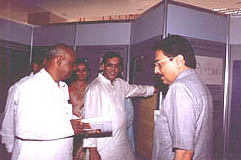 Dr Bindeshwar Pathak, Founder, Sulabh Sanitation Movement, explaining the Sulabh Model to Former Prime Minister Mr. H. D. Deve Gowda at an exhibition organized to coincide with the national seminar on Housing “Adequate Shelter for All” Oct 7–11, 1996. |
Following rapid adoption of the Sulabh technology of pour-flush toilet system, more than 240 towns have been freed from scavenging and 50,000 scavengers liberated and retraining into other professions. It was made possible by converting / constructing more than 1.1 million household latrines. Moreover, Sulabh has built 6,000 community toilets with bath, laundry, and urinal facilities operated on a “pay-and-use” basis.
Sulabh is now operating in 479 districts of 25 states and 4 Union Territories, with over 50,000 trained and experienced workers. Dr. Pathak has achieved this stupendous success, working with a narrow resource base and almost single-handedly, leading a voluntary and non-profit agency. One cannot recall many names who have achieved so much for so many in such a short time. Dr. Pathak did that quietly and without much fanfare.
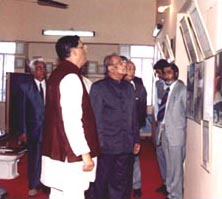 Sri Lankan Minister for Science and Technology, Dr Bernard Soyasa at Sulabh Toilet Museum, New Delhi. |
The year 1974 is a landmark in the history of sanitation when the system of operating and maintaining community toilets with bathing, laundry, and urinal facilities (popularly known as Sulabh Shauchalaya Complex) with attendants service round the clock was initiated on “pay-and-use” basis in Patna. Now Sulabh is operating and maintaining more than 6,000 community complexes in 1,296 towns across the country.
One such complex is in Bhutan. Sulabh has constructed five community toilet complexes in Kabul (Afghanistan). The Ministry of External Affairs provided funds directly to Sulabh for this purpose. These complexes have electricity and 24-hour water supply. The complexes have separate enclosures for men and women. The users are charged a nominal sum for using the toilets and bath facilities. Some of the Sulabh complexes are also provided with bath with shower facility, cloak-rooms, telephones, and primary healthcare. These complexes have been widely welcomed, both by the people and the authorities, due to their cleanliness and good management. The pay-and-use system ensures self-sustainability without any burden on the public, government, or local bodies. The complexes have also improved the living environment considerably.
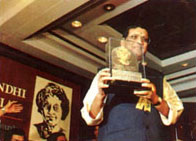 Dr Pathak received the Indira Gandhi Priyadarshini Award at a colorful function in 1994 in New Delhi. |
After establishing neat and clean toilet complexes and liberating scavengers, Sulabh has set up a number of vocational training institutes. One such center is located in the Sulabh Complex at New Delhi. Here, liberated scavengers, their sons and daughters, and people from other weaker sections of society are given training in 10 trades including audio-visual repair, beauty care, computer applications, dress designing, electrical, embroidery, tailoring (cutting and stitching), shorthand, and typewriting. The purpose of imparting vocational training is to give them a new means of livelihood, alleviate poverty, and bring them into the mainstream of society.
Sulabh has set up an English medium school in Delhi for children of the scavengers, the first of its kind in India. Sixty percent of the children are from scavanger families and the remaining are from other castes. This heterogeneous composition ensures that there is enough interaction between kids of scavengers and others. The school aims to prepare children from weaker sections of society for a better life. It brings quality education within the reach of boys and girls from scavenger families.
Dr. Pathak continues his crusade for a better and egalitarian society, but the stigma of untouchability remains deep-rooted. A step-by-step program for the removal of this social curse has been initiated. In 1988, Dr. Pathak led 100 scavengers along with Vedic Brahmins to the famous Nathdwara temple in Rajasthan with a view towards promoting social integration. In 1993, Sulabh embarked on a noble program of social upgradation and integration of thousands of scavenger families.
Under this program, he has made an open appeal to the elite of society to have social interaction with at least one such family to enable them to lead a dignified life as equals in the society. India’s former Prime Minister Mr. I.K. Gujral was among the first few who responded warmly to this suggestion and adopted one scavenger’s family. So far 10,000 scavenger families have been socially upgraded and brought into the mainstream of society. Similar programs are envisaged in a phased manner throughout the country for the removal of untouchability and restoration of human rights and dignity to those who have been deprived of basic civil rights for generations.
Technology mingles with humanitarianism
In 1970, Dr. Pathak launched the Sulabh Sanitation Movement by setting up a social, voluntary, and non-profit organization, Sulabh Shauchalaya Sansthan (which later became Sulabh International Social Service Organization) to carry forward the movement which combined in itself sanitation technology and Dr. Pathak’s humane ideology. This movement, like any other gradual revolution, seeks to change the social structure through reforms based on social consent and technology, judiciously combined in a package to subserve the ultimate goal for which Dr. Pathak has worked all his life, braving the gauntlet of criticism and social scorn which only strengthened his determination to succeed where no one had before.
Sulabh is a protest movement, born out of concern for the liberation of scavengers from the demeaning practice of carrying human excreta on the head. Revolution is a sudden event while the movement indicates a slow gradual development. Sulabh is a movement because it developed step-by-step from technology to liberation to training to rehabilitation and, finally, to social upgradation when scavengers will be absorbed in the social system and scavenging will end forever.
 Dr. Pathak with Mr. I.K.Gujral, former Prime Minister of India. |
Biogas from human excreta
Dr. Pathak is probably the first person in the world who has promoted on a massive scale the idea of obtaining biogas from human excreta collected in large-sized public toilets used by 2,000 to 5,000 people a day. Despite overwhelming odds, he got the first such biogas plant set up at Patna in 1982 after almost six years of research. The successful and satisfactory functioning of this plant encouraged him to replicate the project all over the country and today 176 biogas plants, connected with large-sized public toilets, are operating successfully in many States of the country.
It has been amply demonstrated by Dr. Pathak that, in the absence of sewerage facility, the best option for human waste disposal to be used in conjunction with large public toilets, is the biogas plant. It has the added advantage of being a source of renewable energy which is lacking in a septic tank system.
Biogas from water hyacinth
Biogas from water hyacinth in dried and pulverized form is another achievement of Dr. Pathak. While others had been using this waterweed in its green form by either chopping or pre-treating it with chemicals, Dr. Pathak conducted experiments on dried and pulverized water hyacinth. Although the gas yield in the dried form is about 5–6% less, it is convenient in handling, storage, and transportation. This form also lends itself better for blending with cow-dung, human excreta, or other vegetable wastes used as feed material for biogas production. Yet another “first” Dr. Pathak’s credit is the granulated organic manure obtained from the dried sludge of biogas plants.
Sulabh International Institute of Technical Research and Training (SIITRAT) was founded by Dr. Pathak in 1984 with a view towards providing technological support to the sanitation movement. SIITRAT, with a brilliant team of scientists and engineers, has come up with many new and sustainable technologies. It is now a part of the Sulabh International Academy of Environmental Sanitation.
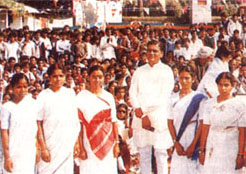 Dr Pathak with sons and daughters of liberated scavengers in Patna. |
Waste water syndrome and its concomitant river and environment pollution currently afflicts nearly all the 5,000 odd towns and cities of India, posing a big challenge to ensure safe and healthy living environment for ever-increasing numbers of city dwellers. One of the major problems with waste water treatment methods is that none of the available technologies has direct economic return. The available technologies are unaffordable due to high capital and maintenance costs.
Sulabh has taken up research-cum-demonstration projects on duckweed-based low-cost waste water treatment in collaboration with concerned government agencies. The ambitious projects are underway in some rural as well as urban areas with direct economic return from pisci-culture and use of duckweed as nutritious feed for poultry and animals.
Solid waste management
Solid waste management has been an increasing problem causing health hazards and environmental pollution. Composting is an important method of biodegradable solid waste management having direct / indirect economic return in the form of manure and soil conditioner. Sulabh has developed a new technology which requires only 5–6 days to make compost from any biodegradable waste without manual handling during composting. Besides quick conversion of wastes into compost, it also helps control diseases transmitted from wastes, as at high temperature pathogens are eliminated from the compost.
Poverty alleviation and rural development
Dr. Pathak also developed the concept of “change agent” for poverty alleviation and rural development. Train a man in a skill and he will find a job for himself. With this conviction, he launched a massive program to expand the human resource base at the grassroots level. Human resource development includes creating ability and willingness to acquire skills and, thus, maximize utilization of available resources and raise productivity per unit of land and capital.
The increase in the level of skill, education, health, and experiences are the indices of human resource development of a society. Dr. Pathak’s approach has been to develop and expand the human resource base at the village level and train youths to work to become catalytic agents working between the suppliers of resources and the beneficiaries.
Sulabh is leading a well-orchestrated campaign for rural development. It is imparting participatory training to school teachers and students in the fields of environmental sanitation and community health. The trained students are playing the role of catalysts to bring about requisite changes in rural areas. Sulabh international Institute of Rural Development, Research and Training (SIIRD) is giving shape to several other projects.
Ensuring health and hygiene
Sulabh International Institute of Health and Hygiene (SIIHH) was started to develop a healthcare and sanitation model of urban slums and villages. Dr. Pathak’s initiative to involve teachers and students in sanitation education and training of women in urban-slums in sanitation and healthcare is radical in its outlook and humane in its approach. Under its medicare program, Sulabh has also opened healthcare centers in community toilet complexes. These centers being run in coordination with government health units, are providing yeoman’s health service to the urban poor. It is training women volunteers in urban slums in collaboration with some national and international agencies. 12,099 of volunteers have been trained in 310 slums.
Sulabh is promoting women group formations after training, which will ensure self-sustainable development. SIIHH is working in collaboration with USAID, UNICEF, Delhi government, Family Health International, and AIDSCAP on many people-friendly projects. The Institute is also disseminating healthcare messages including AIDS awareness through handbooks and pamphlets in the public interest. Recently it has published a popular manual on “Women and Sanitation”.
Museum of Toilets
Sulabh has also established this Museum of Toilets in New Delhi. The Museum has a rare collection of artifacts, pictures, and objects detailing the historic evolution of toilets since 2,500 BC. Moreover, the Museum wing under Dr. Pathak’s guidance, has undertaken the task of publishing an Encyclopedia of Sanitation, which perhaps will be the first of its kind in the world.
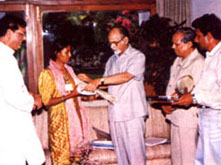 Mr I.K.Gujral, former Prime Minister of India, was among many eminent persons who adopted scavenger families on May 2, 1994 at a function in New Delhi. |
An acknowledged pioneer of Action Sociology, Dr. Pathak has been advocating the introduction of this novel discipline into the academic curriculum. Recently, Action Sociology was introduced in the syllabus at the university level by Rajasthan Vidyapeeth and some other universities. Its concept and vision was conceived and evolved by eminent sociologists under the aegis of the Indian Association of Action Sociologists and the Sulabh Centre for Action Sociology.
An action-oriented movement, Sulabh does not believe in mere armchair analysis of problems. Instead of studying ripples and indulging in sheer rhetoric, it strives to create its own waves. Waves symbolizing major initiatives for social changes. For instance, Sulabh loves to work for the removal of human rights violations through its constructive programs. Championing human rights through mere words has never been the Sulabh ideal. It has been a philosophy of action and a sociology in action.
World toilet summet
Recently, Sulabh was the cosponsor and organizer of World Toilet Summit-2007, held at New Delhi, wherein governmental and non-governmental organizations and individuals, working in the field of sanitation from all over the world, had gathered to exchange ideas, experiences, and technologies, so that they may be used in synergy for greater common good.
Prolific writing
A versatile personality, Dr. Pathak has authored several well-received books including Road to Freedom. He has also frequently contributed thought-provoking write-ups on diverse topics for serious newspapers and magazines. He edits Sulabh India, a development monthly magazine published in English and Hindi.
He has participated and presented papers in a large number of national and international seminars. Dr. Pathak is a widely-travelled person and has visited many countries to disseminate the Sulabh message and technology, and to exchange ideas on environmental sanitation and growth with international experts in the field. The press, both in India and abroad, has widely covered Sulabh’s stupendous track record.
Distinguished visitors from more than 100 countries have visited Sulabh headquarters in Delhi and have appreciated Dr. Pathak’s spirited striving for sanitation and development with equity. Eminent journalists and writers have written extensively on Dr. Pathak — sketching his multi-faceted personality and extraordinary achievements.
Innovative leadership
Sulabh is now diversifying into a number of innovative and environment-friendly development projects to uplift the lot of the poor. Under the dynamic and inspiring leadership of Dr. Pathak, a dedicated team of sociologists, scientists, engineers, journalists, and public-spirited people, has built a large national network and Sulabh is all set to write a glorious chapter in the annals of post-independent India.
Dr. Pathak has become synonymous with Sulabh (its toilets are being used by 10 million people every day) which, in turn, has become the byword for public toilets in India. Besides, being recipient of several awards, laurels, and distinctions, Dr. Pathak is a member of numerous national and international agencies / committees on environmental sanitation, urban development, and related areas. He is also deeply associated with many social, cultural, and philanthropic organizations.
He has rendered yeoman’s service to make our society and environment more healthy and harmonious. He did what no social reformer managed to achieve — he blended his humanitarian philosophy with an environment-friendly technology. It is for these remarkable achievements that he has become a household name in India and is held in high esteem by a grateful society. Mulk Raj Anand, India’s leading writer, has correctly observed, “What Abraham Lincoln did for Blacks in America, Dr. Pathak has done for scavengers in India. Both are great redeemers”.
Dr. Pathak graduated with a Bachelor’s in Sociology in 1964 and earned his Master’s degree in Sociology, topping the list from Patna University in 1980. He earned his Ph.D. on “Liberation of Scavengers Through Low-Cost Sanitation” in 1985 and his Master’s degree in English, topping the list from Patna University in 1986. He earned his D.Litt. on “Eradication of Scavenging and Environmental Sanitation in India — a Sociological Study” in 1994.
He authored Road to Freedom (A Sociological Study on the Abolition of Scavenging in India), Constitutional Safeguards for Weaker, Rural violence in Bihar, and Agricultural Engineering in Development: Human Resource Development-Training and Education Programmes.
